1988 OPEL CALIBRA key
[x] Cancel search: keyPage 109 of 525
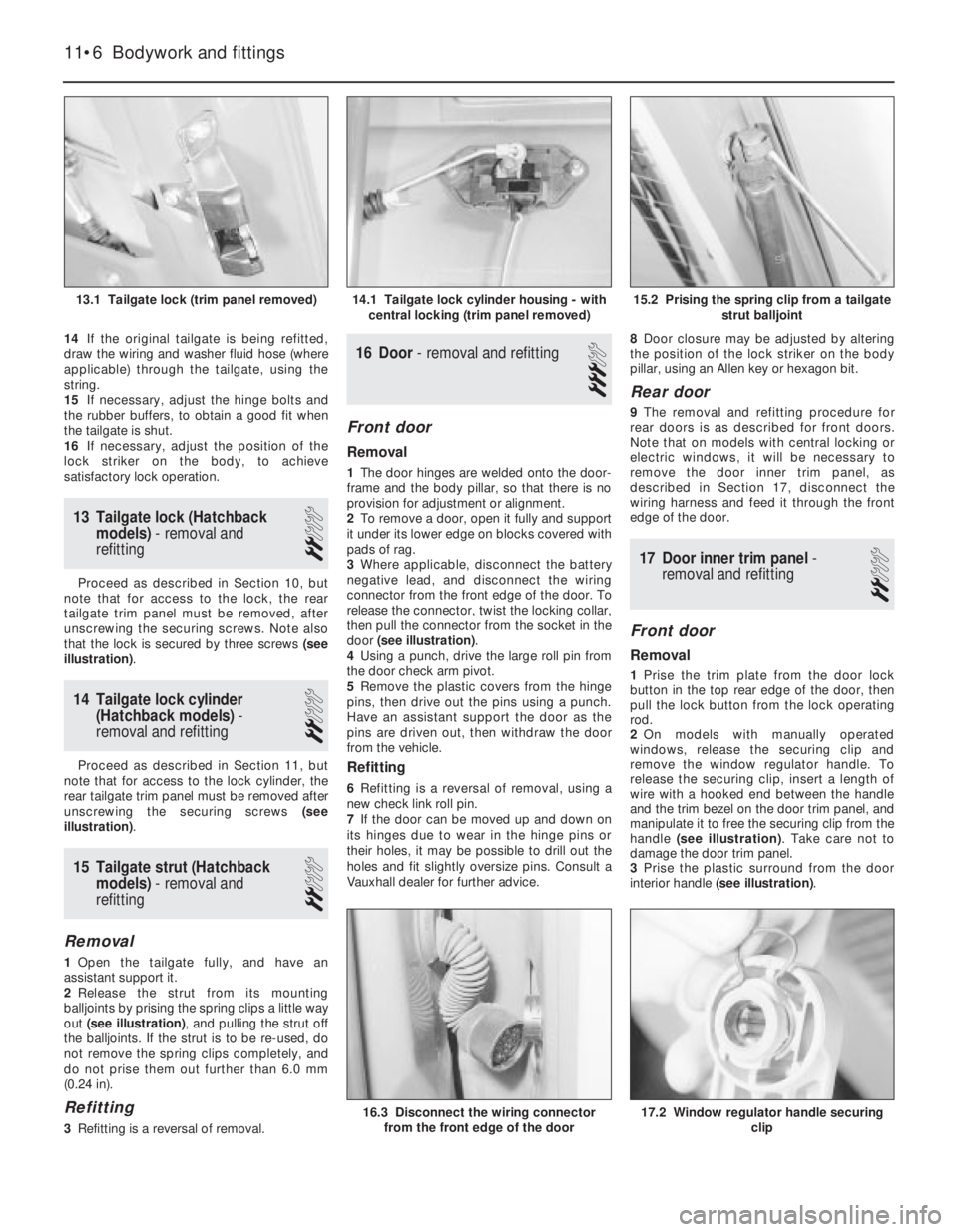
14If the original tailgate is being refitted,
draw the wiring and washer fluid hose (where
applicable) through the tailgate, using the
string.
15If necessary, adjust the hinge bolts and
the rubber buffers, to obtain a good fit when
the tailgate is shut.
16If necessary, adjust the position of the
lock striker on the body, to achieve
satisfactory lock operation.
13Tailgate lock (Hatchback
models) - removal and
refitting
2
Proceed as described in Section 10, but
note that for access to the lock, the rear
tailgate trim panel must be removed, after
unscrewing the securing screws. Note also
that the lock is secured by three screws (see
illustration).
14Tailgate lock cylinder
(Hatchback models) -
removal and refitting
2
Proceed as described in Section 11, but
note that for access to the lock cylinder, the
rear tailgate trim panel must be removed after
unscrewing the securing screws (see
illustration).
15Tailgate strut (Hatchback
models) - removal and
refitting
2
Removal
1Open the tailgate fully, and have an
assistant support it.
2Release the strut from its mounting
balljoints by prising the spring clips a little way
out (see illustration), and pulling the strut off
the balljoints. If the strut is to be re-used, do
not remove the spring clips completely, and
do not prise them out further than 6.0 mm
(0.24 in).
Refitting
3Refitting is a reversal of removal.
16Door - removal and refitting
3
Front door
Removal
1The door hinges are welded onto the door-
frame and the body pillar, so that there is no
provision for adjustment or alignment.
2To remove a door, open it fully and support
it under its lower edge on blocks covered with
pads of rag.
3Where applicable, disconnect the battery
negative lead, and disconnect the wiring
connector from the front edge of the door. To
release the connector, twist the locking collar,
then pull the connector from the socket in the
door (see illustration).
4Using a punch, drive the large roll pin from
the door check arm pivot.
5Remove the plastic covers from the hinge
pins, then drive out the pins using a punch.
Have an assistant support the door as the
pins are driven out, then withdraw the door
from the vehicle.
Refitting
6Refitting is a reversal of removal, using a
new check link roll pin.
7If the door can be moved up and down on
its hinges due to wear in the hinge pins or
their holes, it may be possible to drill out the
holes and fit slightly oversize pins. Consult a
Vauxhall dealer for further advice.8Door closure may be adjusted by altering
the position of the lock striker on the body
pillar, using an Allen key or hexagon bit.
Rear door
9The removal and refitting procedure for
rear doors is as described for front doors.
Note that on models with central locking or
electric windows, it will be necessary to
remove the door inner trim panel, as
described in Section 17, disconnect the
wiring harness and feed it through the front
edge of the door.
17Door inner trim panel -
removal and refitting
2
Front door
Removal
1Prise the trim plate from the door lock
button in the top rear edge of the door, then
pull the lock button from the lock operating
rod.
2On models with manually operated
windows, release the securing clip and
remove the window regulator handle. To
release the securing clip, insert a length of
wire with a hooked end between the handle
and the trim bezel on the door trim panel, and
manipulate it to free the securing clip from the
handle (see illustration). Take care not to
damage the door trim panel.
3Prise the plastic surround from the door
interior handle (see illustration).
11•6Bodywork and fittings
15.2 Prising the spring clip from a tailgate
strut balljoint
17.2 Window regulator handle securing
clip16.3 Disconnect the wiring connector
from the front edge of the door
14.1 Tailgate lock cylinder housing - with
central locking (trim panel removed)13.1 Tailgate lock (trim panel removed)
Page 111 of 525
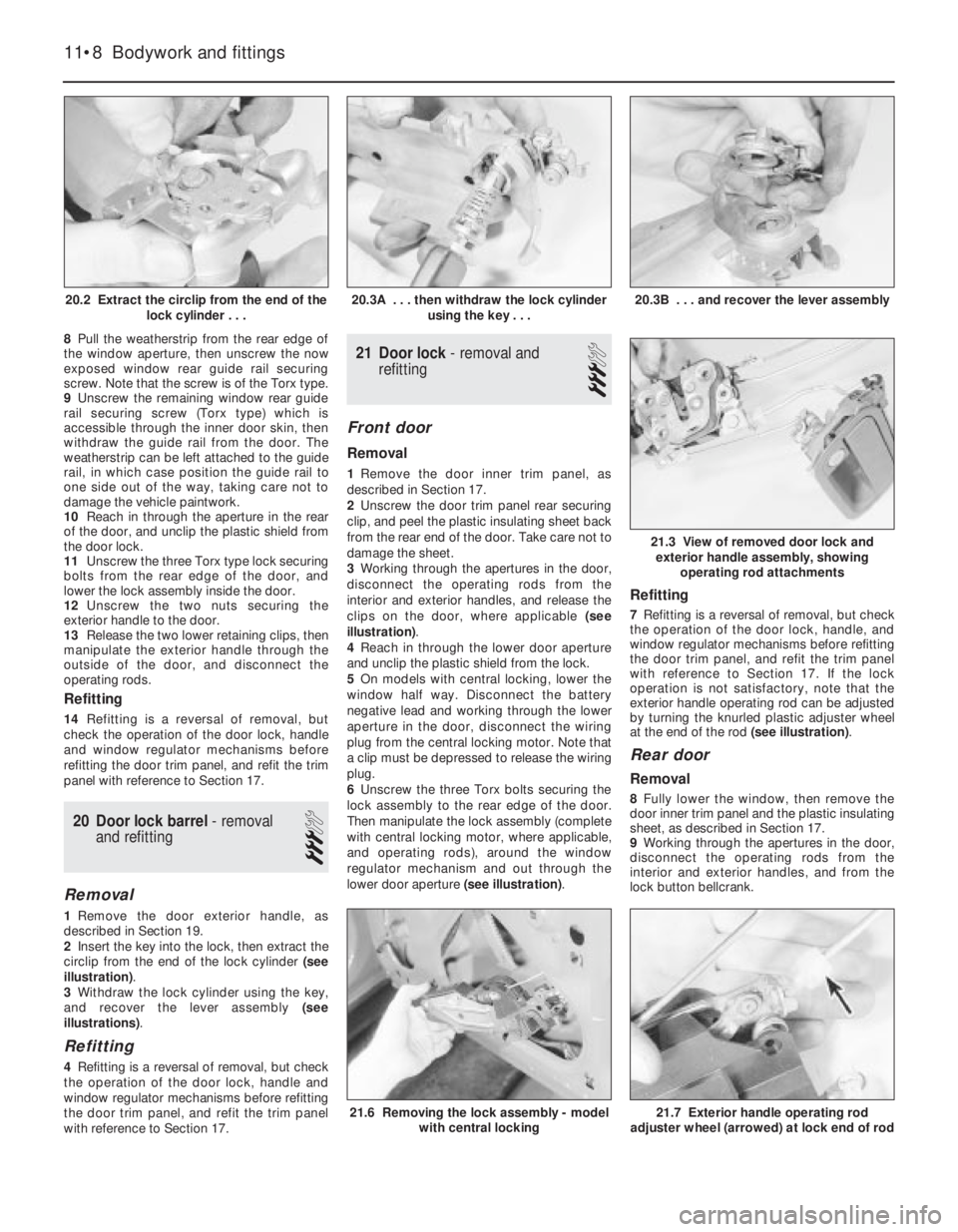
8Pull the weatherstrip from the rear edge of
the window aperture, then unscrew the now
exposed window rear guide rail securing
screw. Note that the screw is of the Torx type.
9Unscrew the remaining window rear guide
rail securing screw (Torx type) which is
accessible through the inner door skin, then
withdraw the guide rail from the door. The
weatherstrip can be left attached to the guide
rail, in which case position the guide rail to
one side out of the way, taking care not to
damage the vehicle paintwork.
10Reach in through the aperture in the rear
of the door, and unclip the plastic shield from
the door lock.
11Unscrew the three Torx type lock securing
bolts from the rear edge of the door, and
lower the lock assembly inside the door.
12Unscrew the two nuts securing the
exterior handle to the door.
13Release the two lower retaining clips, then
manipulate the exterior handle through the
outside of the door, and disconnect the
operating rods.
Refitting
14Refitting is a reversal of removal, but
check the operation of the door lock, handle
and window regulator mechanisms before
refitting the door trim panel, and refit the trim
panel with reference to Section 17.
20Door lock barrel - removal
and refitting
3
Removal
1Remove the door exterior handle, as
described in Section 19.
2Insert the key into the lock, then extract the
circlip from the end of the lock cylinder (see
illustration).
3Withdraw the lock cylinder using the key,
and recover the lever assembly (see
illustrations).
Refitting
4 Refitting is a reversal of removal, but check
the operation of the door lock, handle and
window regulator mechanisms before refitting
the door trim panel, and refit the trim panel
with reference to Section 17.
21Door lock -removal and
refitting
3
Front door
Removal
1Remove the door inner trim panel, as
described in Section 17.
2Unscrew the door trim panel rear securing
clip, and peel the plastic insulating sheet back
from the rear end of the door. Take care not to
damage the sheet.
3Working through the apertures in the door,
disconnect the operating rods from the
interior and exterior handles, and release the
clips on the door, where applicable (see
illustration).
4Reach in through the lower door aperture
and unclip the plastic shield from the lock.
5On models with central locking, lower the
window half way. Disconnect the battery
negative lead and working through the lower
aperture in the door, disconnect the wiring
plug from the central locking motor. Note that
a clip must be depressed to release the wiring
plug.
6Unscrew the three Torx bolts securing the
lock assembly to the rear edge of the door.
Then manipulate the lock assembly (complete
with central locking motor, where applicable,
and operating rods), around the window
regulator mechanism and out through the
lower door aperture (see illustration).
Refitting
7Refitting is a reversal of removal, but check
the operation of the door lock, handle, and
window regulator mechanisms before refitting
the door trim panel, and refit the trim panel
with reference to Section 17. If the lock
operation is not satisfactory, note that the
exterior handle operating rod can be adjusted
by turning the knurled plastic adjuster wheel
at the end of the rod (see illustration).
Rear door
Removal
8Fully lower the window, then remove the
door inner trim panel and the plastic insulating
sheet, as described in Section 17.
9Working through the apertures in the door,
disconnect the operating rods from the
interior and exterior handles, and from the
lock button bellcrank.
11•8Bodywork and fittings
20.2 Extract the circlip from the end of the
lock cylinder . . .20.3B . . . and recover the lever assembly
21.7 Exterior handle operating rod
adjuster wheel (arrowed) at lock end of rod21.6 Removing the lock assembly - model
with central locking
21.3 View of removed door lock and
exterior handle assembly, showing
operating rod attachments
20.3A . . . then withdraw the lock cylinder
using the key . . .
Page 135 of 525
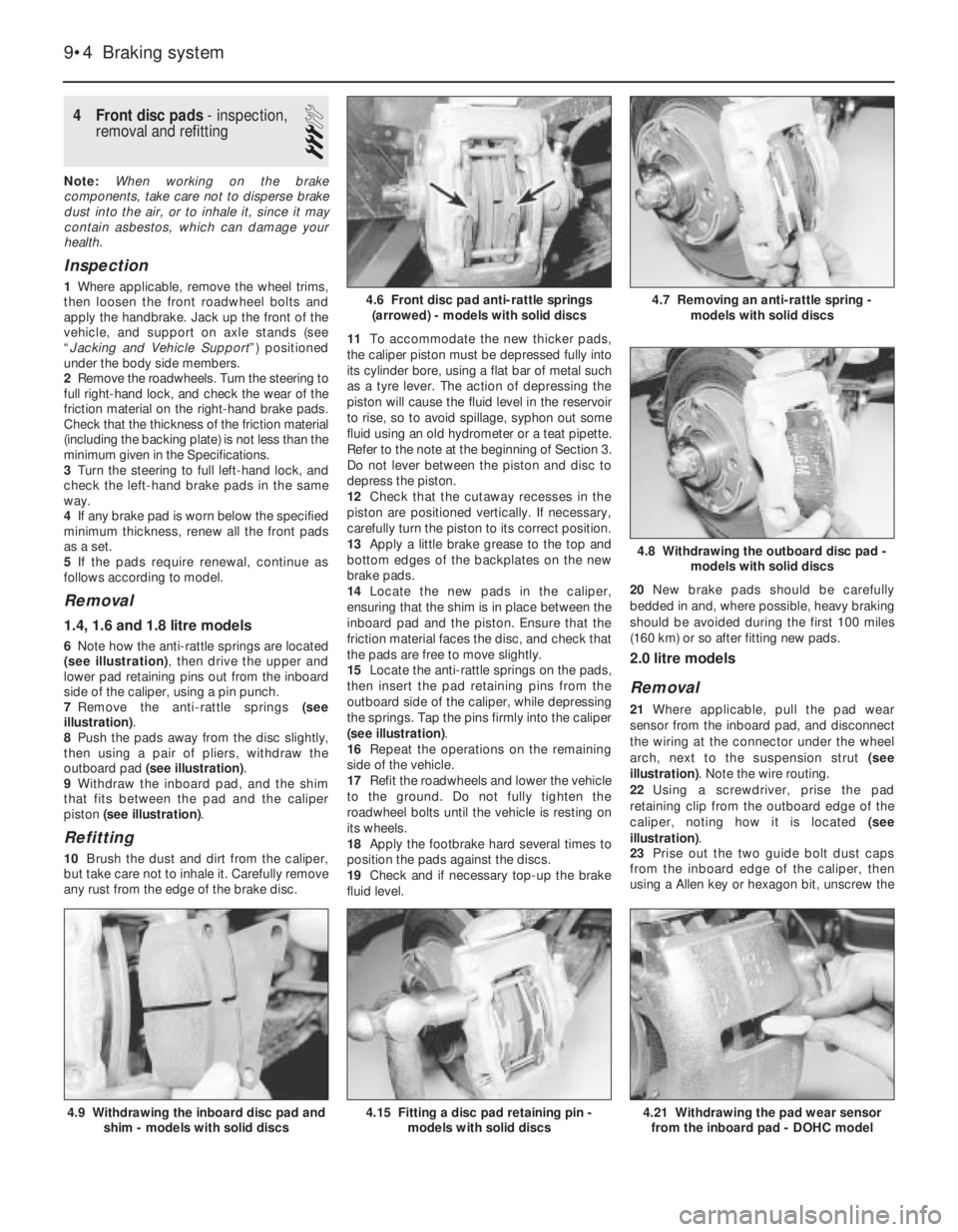
4Front disc pads - inspection,
removal and refitting
3
Note: When working on the brake
components, take care not to disperse brake
dust into the air, or to inhale it, since it may
contain asbestos, which can damage your
health.
Inspection
1Where applicable, remove the wheel trims,
then loosen the front roadwheel bolts and
apply the handbrake. Jack up the front of the
vehicle, and support on axle stands (see
“Jacking and Vehicle Support”) positioned
under the body side members.
2Remove the roadwheels. Turn the steering to
full right-hand lock, and check the wear of the
friction material on the right-hand brake pads.
Check that the thickness of the friction material
(including the backing plate) is not less than the
minimum given in the Specifications.
3Turn the steering to full left-hand lock, and
check the left-hand brake pads in the same
way.
4If any brake pad is worn below the specified
minimum thickness, renew all the front pads
as a set.
5If the pads require renewal, continue as
follows according to model.
Removal
1.4, 1.6 and 1.8 litre models
6Note how the anti-rattle springs are located
(see illustration), then drive the upper and
lower pad retaining pins out from the inboard
side of the caliper, using a pin punch.
7Remove the anti-rattle springs (see
illustration).
8Push the pads away from the disc slightly,
then using a pair of pliers, withdraw the
outboard pad (see illustration).
9Withdraw the inboard pad, and the shim
that fits between the pad and the caliper
piston (see illustration).
Refitting
10Brush the dust and dirt from the caliper,
but take care not to inhale it. Carefully remove
any rust from the edge of the brake disc.11To accommodate the new thicker pads,
the caliper piston must be depressed fully into
its cylinder bore, using a flat bar of metal such
as a tyre lever. The action of depressing the
piston will cause the fluid level in the reservoir
to rise, so to avoid spillage, syphon out some
fluid using an old hydrometer or a teat pipette.
Refer to the note at the beginning of Section 3.
Do not lever between the piston and disc to
depress the piston.
12Check that the cutaway recesses in the
piston are positioned vertically. If necessary,
carefully turn the piston to its correct position.
13Apply a little brake grease to the top and
bottom edges of the backplates on the new
brake pads.
14Locate the new pads in the caliper,
ensuring that the shim is in place between the
inboard pad and the piston. Ensure that the
friction material faces the disc, and check that
the pads are free to move slightly.
15Locate the anti-rattle springs on the pads,
then insert the pad retaining pins from the
outboard side of the caliper, while depressing
the springs. Tap the pins firmly into the caliper
(see illustration).
16Repeat the operations on the remaining
side of the vehicle.
17Refit the roadwheels and lower the vehicle
to the ground. Do not fully tighten the
roadwheel bolts until the vehicle is resting on
its wheels.
18Apply the footbrake hard several times to
position the pads against the discs.
19Check and if necessary top-up the brake
fluid level.20New brake pads should be carefully
bedded in and, where possible, heavy braking
should be avoided during the first 100 miles
(160 km) or so after fitting new pads.
2.0 litre models
Removal
21Where applicable, pull the pad wear
sensor from the inboard pad, and disconnect
the wiring at the connector under the wheel
arch, next to the suspension strut (see
illustration). Note the wire routing.
22Using a screwdriver, prise the pad
retaining clip from the outboard edge of the
caliper, noting how it is located (see
illustration).
23Prise out the two guide bolt dust caps
from the inboard edge of the caliper, then
using a Allen key or hexagon bit, unscrew the
9•4Braking system
4.6 Front disc pad anti-rattle springs
(arrowed) - models with solid discs
4.8 Withdrawing the outboard disc pad -
models with solid discs
4.21 Withdrawing the pad wear sensor
from the inboard pad - DOHC model4.15 Fitting a disc pad retaining pin -
models with solid discs4.9 Withdrawing the inboard disc pad and
shim - models with solid discs
4.7 Removing an anti-rattle spring -
models with solid discs
Page 139 of 525
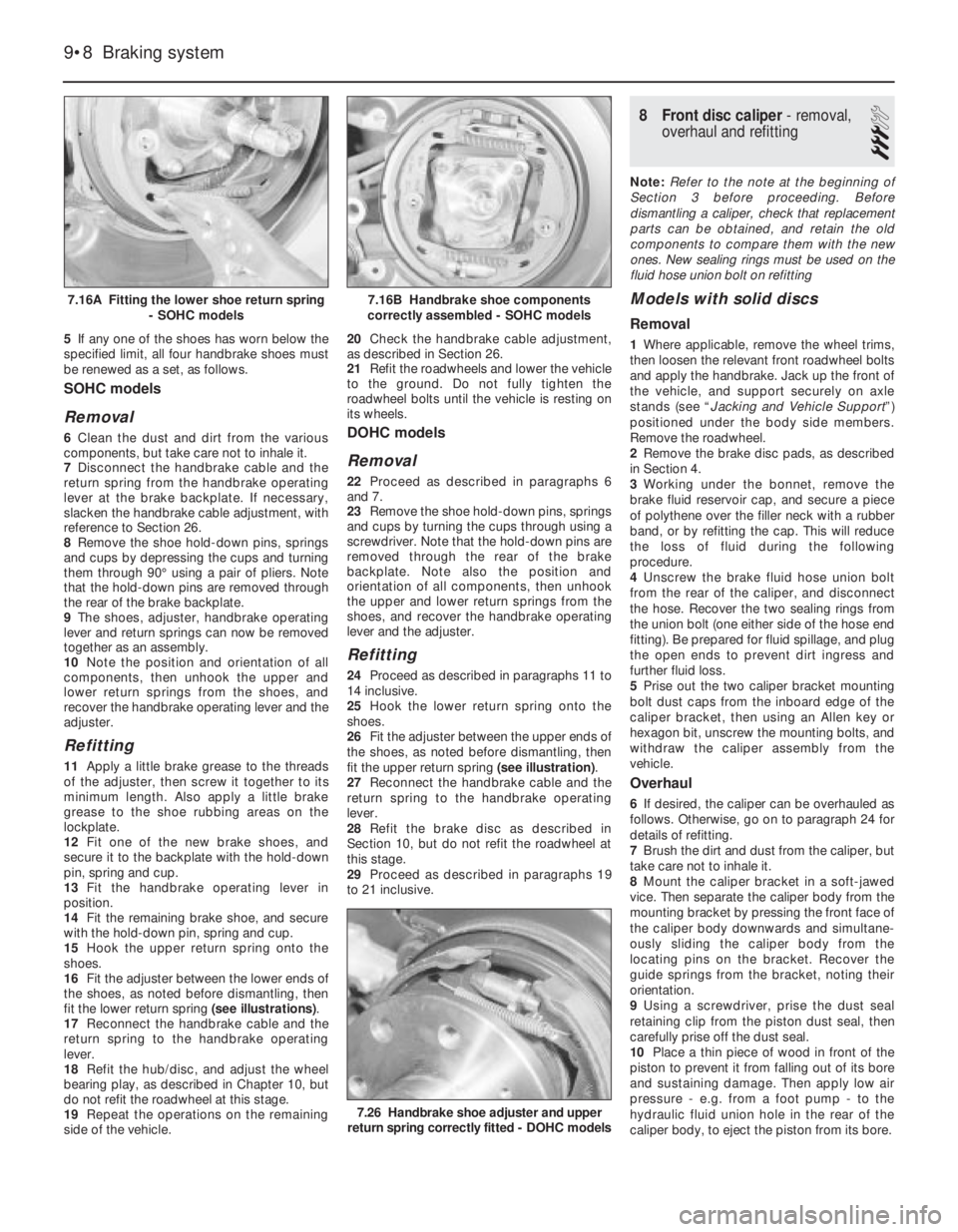
5If any one of the shoes has worn below the
specified limit, all four handbrake shoes must
be renewed as a set, as follows.
SOHC models
Removal
6Clean the dust and dirt from the various
components, but take care not to inhale it.
7Disconnect the handbrake cable and the
return spring from the handbrake operating
lever at the brake backplate. If necessary,
slacken the handbrake cable adjustment, with
reference to Section 26.
8Remove the shoe hold-down pins, springs
and cups by depressing the cups and turning
them through 90°using a pair of pliers. Note
that the hold-down pins are removed through
the rear of the brake backplate.
9The shoes, adjuster, handbrake operating
lever and return springs can now be removed
together as an assembly.
10Note the position and orientation of all
components, then unhook the upper and
lower return springs from the shoes, and
recover the handbrake operating lever and the
adjuster.
Refitting
11Apply a little brake grease to the threads
of the adjuster, then screw it together to its
minimum length. Also apply a little brake
grease to the shoe rubbing areas on the
lockplate.
12Fit one of the new brake shoes, and
secure it to the backplate with the hold-down
pin, spring and cup.
13Fit the handbrake operating lever in
position.
14Fit the remaining brake shoe, and secure
with the hold-down pin, spring and cup.
15Hook the upper return spring onto the
shoes.
16Fit the adjuster between the lower ends of
the shoes, as noted before dismantling, then
fit the lower return spring (see illustrations).
17Reconnect the handbrake cable and the
return spring to the handbrake operating
lever.
18Refit the hub/disc, and adjust the wheel
bearing play, as described in Chapter 10, but
do not refit the roadwheel at this stage.
19Repeat the operations on the remaining
side of the vehicle.20Check the handbrake cable adjustment,
as described in Section 26.
21Refit the roadwheels and lower the vehicle
to the ground. Do not fully tighten the
roadwheel bolts until the vehicle is resting on
its wheels.
DOHC models
Removal
22Proceed as described in paragraphs 6
and 7.
23Remove the shoe hold-down pins, springs
and cups by turning the cups through using a
screwdriver. Note that the hold-down pins are
removed through the rear of the brake
backplate. Note also the position and
orientation of all components, then unhook
the upper and lower return springs from the
shoes, and recover the handbrake operating
lever and the adjuster.
Refitting
24Proceed as described in paragraphs 11 to
14 inclusive.
25Hook the lower return spring onto the
shoes.
26Fit the adjuster between the upper ends of
the shoes, as noted before dismantling, then
fit the upper return spring (see illustration).
27Reconnect the handbrake cable and the
return spring to the handbrake operating
lever.
28Refit the brake disc as described in
Section 10, but do not refit the roadwheel at
this stage.
29Proceed as described in paragraphs 19
to 21 inclusive.
8Front disc caliper - removal,
overhaul and refitting
3
Note: Refer to the note at the beginning of
Section 3 before proceeding. Before
dismantling a caliper, check that replacement
parts can be obtained, and retain the old
components to compare them with the new
ones. New sealing rings must be used on the
fluid hose union bolt on refitting
Models with solid discs
Removal
1Where applicable, remove the wheel trims,
then loosen the relevant front roadwheel bolts
and apply the handbrake. Jack up the front of
the vehicle, and support securely on axle
stands (see “Jacking and Vehicle Support”)
positioned under the body side members.
Remove the roadwheel.
2Remove the brake disc pads, as described
in Section 4.
3Working under the bonnet, remove the
brake fluid reservoir cap, and secure a piece
of polythene over the filler neck with a rubber
band, or by refitting the cap. This will reduce
the loss of fluid during the following
procedure.
4Unscrew the brake fluid hose union bolt
from the rear of the caliper, and disconnect
the hose. Recover the two sealing rings from
the union bolt (one either side of the hose end
fitting). Be prepared for fluid spillage, and plug
the open ends to prevent dirt ingress and
further fluid loss.
5Prise out the two caliper bracket mounting
bolt dust caps from the inboard edge of the
caliper bracket, then using an Allen key or
hexagon bit, unscrew the mounting bolts, and
withdraw the caliper assembly from the
vehicle.
Overhaul
6If desired, the caliper can be overhauled as
follows. Otherwise, go on to paragraph 24 for
details of refitting.
7Brush the dirt and dust from the caliper, but
take care not to inhale it.
8Mount the caliper bracket in a soft-jawed
vice. Then separate the caliper body from the
mounting bracket by pressing the front face of
the caliper body downwards and simultane-
ously sliding the caliper body from the
locating pins on the bracket. Recover the
guide springs from the bracket, noting their
orientation.
9Using a screwdriver, prise the dust seal
retaining clip from the piston dust seal, then
carefully prise off the dust seal.
10Place a thin piece of wood in front of the
piston to prevent it from falling out of its bore
and sustaining damage. Then apply low air
pressure - e.g. from a foot pump - to the
hydraulic fluid union hole in the rear of the
caliper body, to eject the piston from its bore.
9•8Braking system
7.16A Fitting the lower shoe return spring
- SOHC models
7.26 Handbrake shoe adjuster and upper
return spring correctly fitted - DOHC models
7.16B Handbrake shoe components
correctly assembled - SOHC models
Page 143 of 525
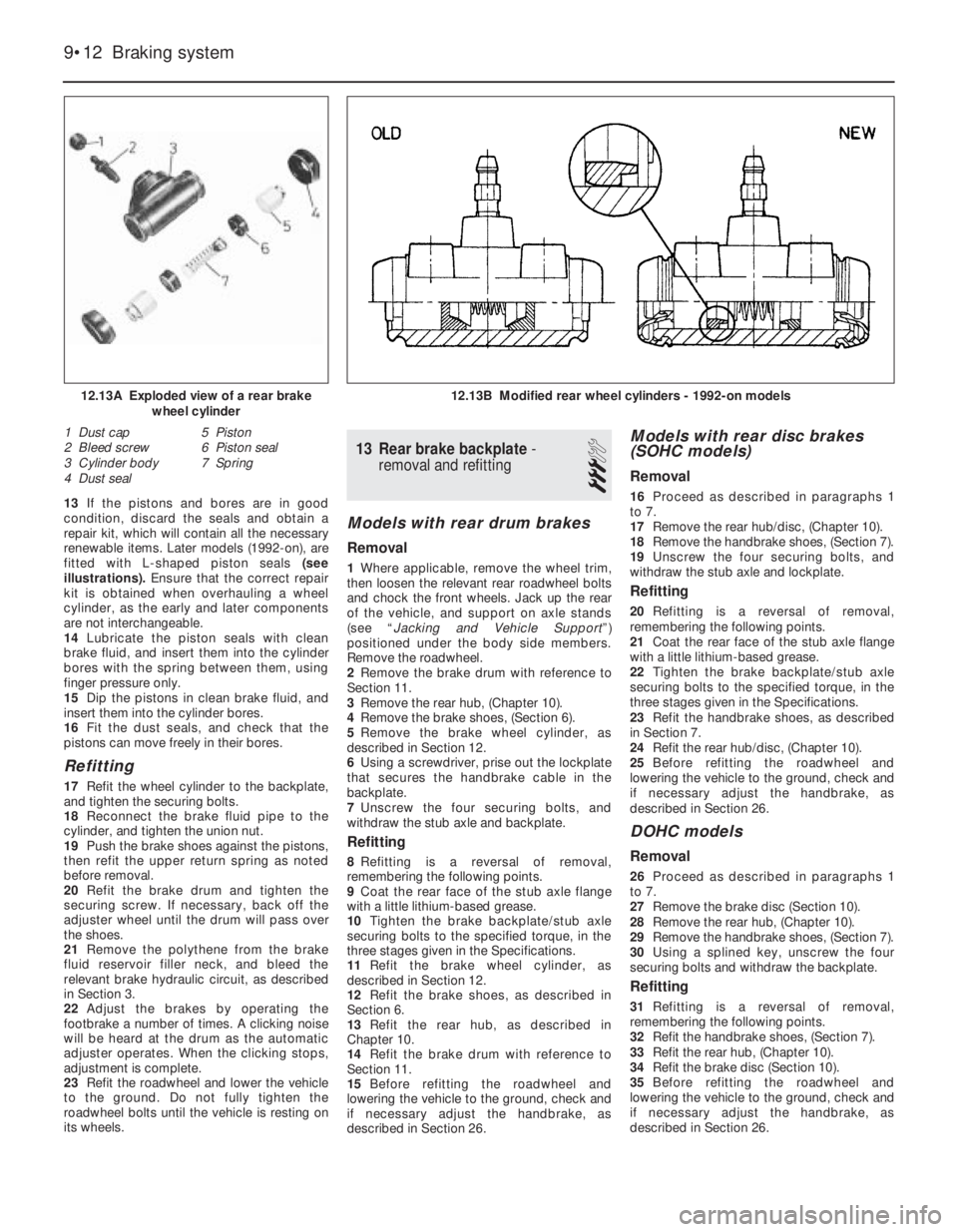
13If the pistons and bores are in good
condition, discard the seals and obtain a
repair kit, which will contain all the necessary
renewable items. Later models (1992-on), are
fitted with L-shaped piston seals (see
illustrations). Ensure that the correct repair
kit is obtained when overhauling a wheel
cylinder, as the early and later components
are not interchangeable.
14Lubricate the piston seals with clean
brake fluid, and insert them into the cylinder
bores with the spring between them, using
finger pressure only.
15Dip the pistons in clean brake fluid, and
insert them into the cylinder bores.
16Fit the dust seals, and check that the
pistons can move freely in their bores.
Refitting
17Refit the wheel cylinder to the backplate,
and tighten the securing bolts.
18Reconnect the brake fluid pipe to the
cylinder, and tighten the union nut.
19Push the brake shoes against the pistons,
then refit the upper return spring as noted
before removal.
20Refit the brake drum and tighten the
securing screw. If necessary, back off the
adjuster wheel until the drum will pass over
the shoes.
21Remove the polythene from the brake
fluid reservoir filler neck, and bleed the
relevant brake hydraulic circuit, as described
in Section 3.
22Adjust the brakes by operating the
footbrake a number of times. A clicking noise
will be heard at the drum as the automatic
adjuster operates. When the clicking stops,
adjustment is complete.
23Refit the roadwheel and lower the vehicle
to the ground. Do not fully tighten the
roadwheel bolts until the vehicle is resting on
its wheels.
13Rear brake backplate -
removal and refitting
3
Models with rear drum brakes
Removal
1Where applicable, remove the wheel trim,
then loosen the relevant rear roadwheel bolts
and chock the front wheels. Jack up the rear
of the vehicle, and support on axle stands
(see “Jacking and Vehicle Support”)
positioned under the body side members.
Remove the roadwheel.
2Remove the brake drum with reference to
Section 11.
3Remove the rear hub, (Chapter 10).
4Remove the brake shoes, (Section 6).
5Remove the brake wheel cylinder, as
described in Section 12.
6Using a screwdriver, prise out the lockplate
that secures the handbrake cable in the
backplate.
7Unscrew the four securing bolts, and
withdraw the stub axle and backplate.
Refitting
8Refitting is a reversal of removal,
remembering the following points.
9Coat the rear face of the stub axle flange
with a little lithium-based grease.
10Tighten the brake backplate/stub axle
securing bolts to the specified torque, in the
three stages given in the Specifications.
11Refit the brake wheel cylinder, as
described in Section 12.
12Refit the brake shoes, as described in
Section 6.
13Refit the rear hub, as described in
Chapter 10.
14Refit the brake drum with reference to
Section 11.
15Before refitting the roadwheel and
lowering the vehicle to the ground, check and
if necessary adjust the handbrake, as
described in Section 26.
Models with rear disc brakes
(SOHC models)
Removal
16Proceed as described in paragraphs 1
to 7.
17Remove the rear hub/disc, (Chapter 10).
18Remove the handbrake shoes, (Section 7).
19Unscrew the four securing bolts, and
withdraw the stub axle and lockplate.
Refitting
20Refitting is a reversal of removal,
remembering the following points.
21Coat the rear face of the stub axle flange
with a little lithium-based grease.
22Tighten the brake backplate/stub axle
securing bolts to the specified torque, in the
three stages given in the Specifications.
23Refit the handbrake shoes, as described
in Section 7.
24Refit the rear hub/disc, (Chapter 10).
25Before refitting the roadwheel and
lowering the vehicle to the ground, check and
if necessary adjust the handbrake, as
described in Section 26.
DOHC models
Removal
26Proceed as described in paragraphs 1
to 7.
27Remove the brake disc (Section 10).
28Remove the rear hub, (Chapter 10).
29Remove the handbrake shoes, (Section 7).
30Using a splined key, unscrew the four
securing bolts and withdraw the backplate.
Refitting
31Refitting is a reversal of removal,
remembering the following points.
32Refit the handbrake shoes, (Section 7).
33Refit the rear hub, (Chapter 10).
34Refit the brake disc (Section 10).
35Before refitting the roadwheel and
lowering the vehicle to the ground, check and
if necessary adjust the handbrake, as
described in Section 26.
9•12Braking system
12.13A Exploded view of a rear brake
wheel cylinder
1 Dust cap
2 Bleed screw
3 Cylinder body
4 Dust seal5 Piston
6 Piston seal
7 Spring
12.13B Modified rear wheel cylinders - 1992-on models
Page 146 of 525
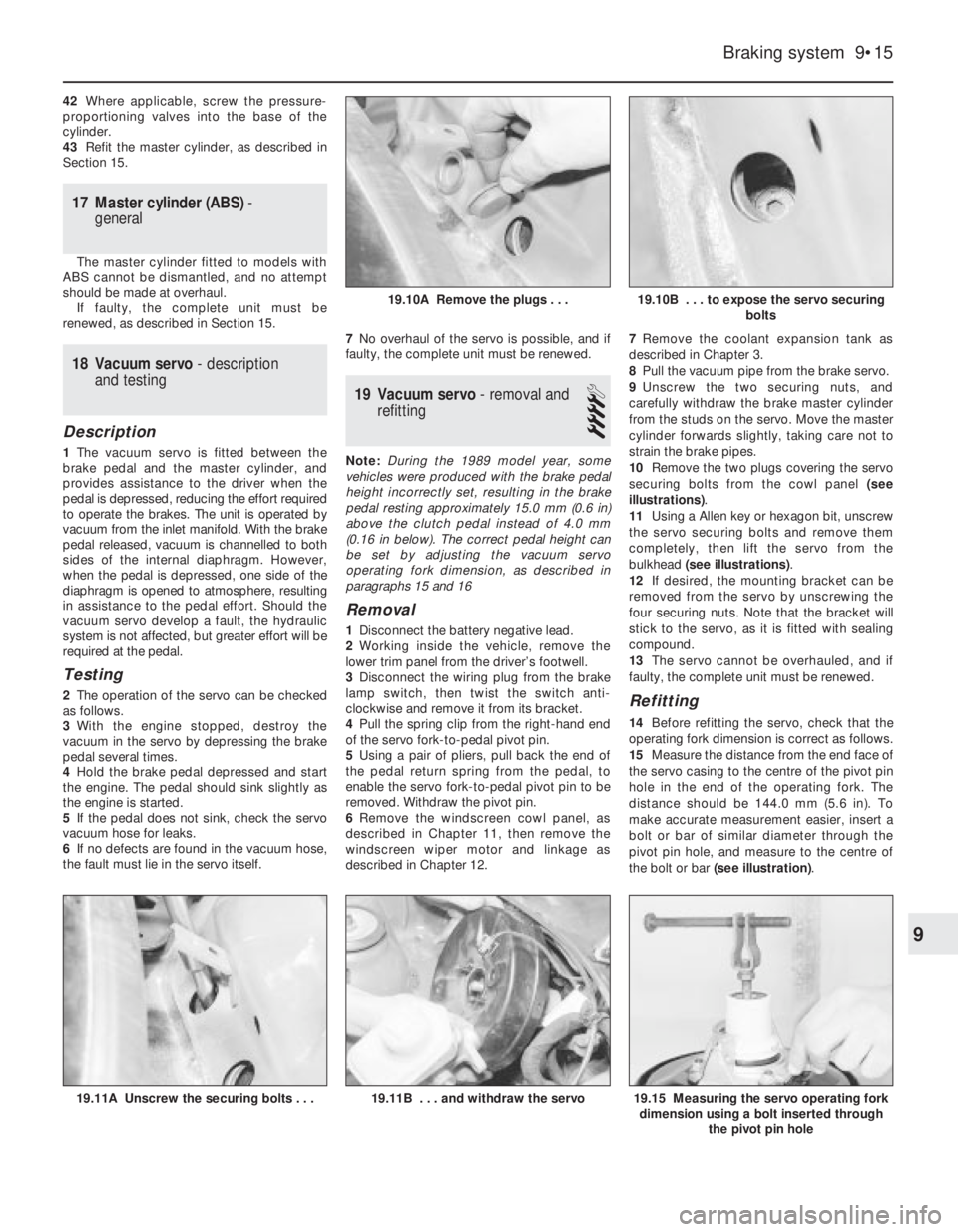
42Where applicable, screw the pressure-
proportioning valves into the base of the
cylinder.
43Refit the master cylinder, as described in
Section 15.
17Master cylinder (ABS) -
general
The master cylinder fitted to models with
ABS cannot be dismantled, and no attempt
should be made at overhaul.
If faulty, the complete unit must be
renewed, as described in Section 15.
18Vacuum servo - description
and testing
Description
1The vacuum servo is fitted between the
brake pedal and the master cylinder, and
provides assistance to the driver when the
pedal is depressed, reducing the effort required
to operate the brakes. The unit is operated by
vacuum from the inlet manifold. With the brake
pedal released, vacuum is channelled to both
sides of the internal diaphragm. However,
when the pedal is depressed, one side of the
diaphragm is opened to atmosphere, resulting
in assistance to the pedal effort. Should the
vacuum servo develop a fault, the hydraulic
system is not affected, but greater effort will be
required at the pedal.
Testing
2The operation of the servo can be checked
as follows.
3With the engine stopped, destroy the
vacuum in the servo by depressing the brake
pedal several times.
4Hold the brake pedal depressed and start
the engine. The pedal should sink slightly as
the engine is started.
5If the pedal does not sink, check the servo
vacuum hose for leaks.
6If no defects are found in the vacuum hose,
the fault must lie in the servo itself.7No overhaul of the servo is possible, and if
faulty, the complete unit must be renewed.
19Vacuum servo - removal and
refitting
4
Note: During the 1989 model year, some
vehicles were produced with the brake pedal
height incorrectly set, resulting in the brake
pedal resting approximately 15.0 mm (0.6 in)
above the clutch pedal instead of 4.0 mm
(0.16 in below). The correct pedal height can
be set by adjusting the vacuum servo
operating fork dimension, as described in
paragraphs 15 and 16
Removal
1Disconnect the battery negative lead.
2Working inside the vehicle, remove the
lower trim panel from the driver’s footwell.
3Disconnect the wiring plug from the brake
lamp switch, then twist the switch anti-
clockwise and remove it from its bracket.
4Pull the spring clip from the right-hand end
of the servo fork-to-pedal pivot pin.
5Using a pair of pliers, pull back the end of
the pedal return spring from the pedal, to
enable the servo fork-to-pedal pivot pin to be
removed. Withdraw the pivot pin.
6Remove the windscreen cowl panel, as
described in Chapter 11, then remove the
windscreen wiper motor and linkage as
described in Chapter 12.7Remove the coolant expansion tank as
described in Chapter 3.
8Pull the vacuum pipe from the brake servo.
9Unscrew the two securing nuts, and
carefully withdraw the brake master cylinder
from the studs on the servo. Move the master
cylinder forwards slightly, taking care not to
strain the brake pipes.
10Remove the two plugs covering the servo
securing bolts from the cowl panel (see
illustrations).
11Using a Allen key or hexagon bit, unscrew
the servo securing bolts and remove them
completely, then lift the servo from the
bulkhead (see illustrations).
12If desired, the mounting bracket can be
removed from the servo by unscrewing the
four securing nuts. Note that the bracket will
stick to the servo, as it is fitted with sealing
compound.
13The servo cannot be overhauled, and if
faulty, the complete unit must be renewed.
Refitting
14Before refitting the servo, check that the
operating fork dimension is correct as follows.
15Measure the distance from the end face of
the servo casing to the centre of the pivot pin
hole in the end of the operating fork. The
distance should be 144.0 mm (5.6 in). To
make accurate measurement easier, insert a
bolt or bar of similar diameter through the
pivot pin hole, and measure to the centre of
the bolt or bar (see illustration).
Braking system 9•15
19.11A Unscrew the securing bolts . . .19.15 Measuring the servo operating fork
dimension using a bolt inserted through
the pivot pin hole19.11B . . . and withdraw the servo
19.10B . . . to expose the servo securing
bolts19.10A Remove the plugs . . .
9
Page 147 of 525
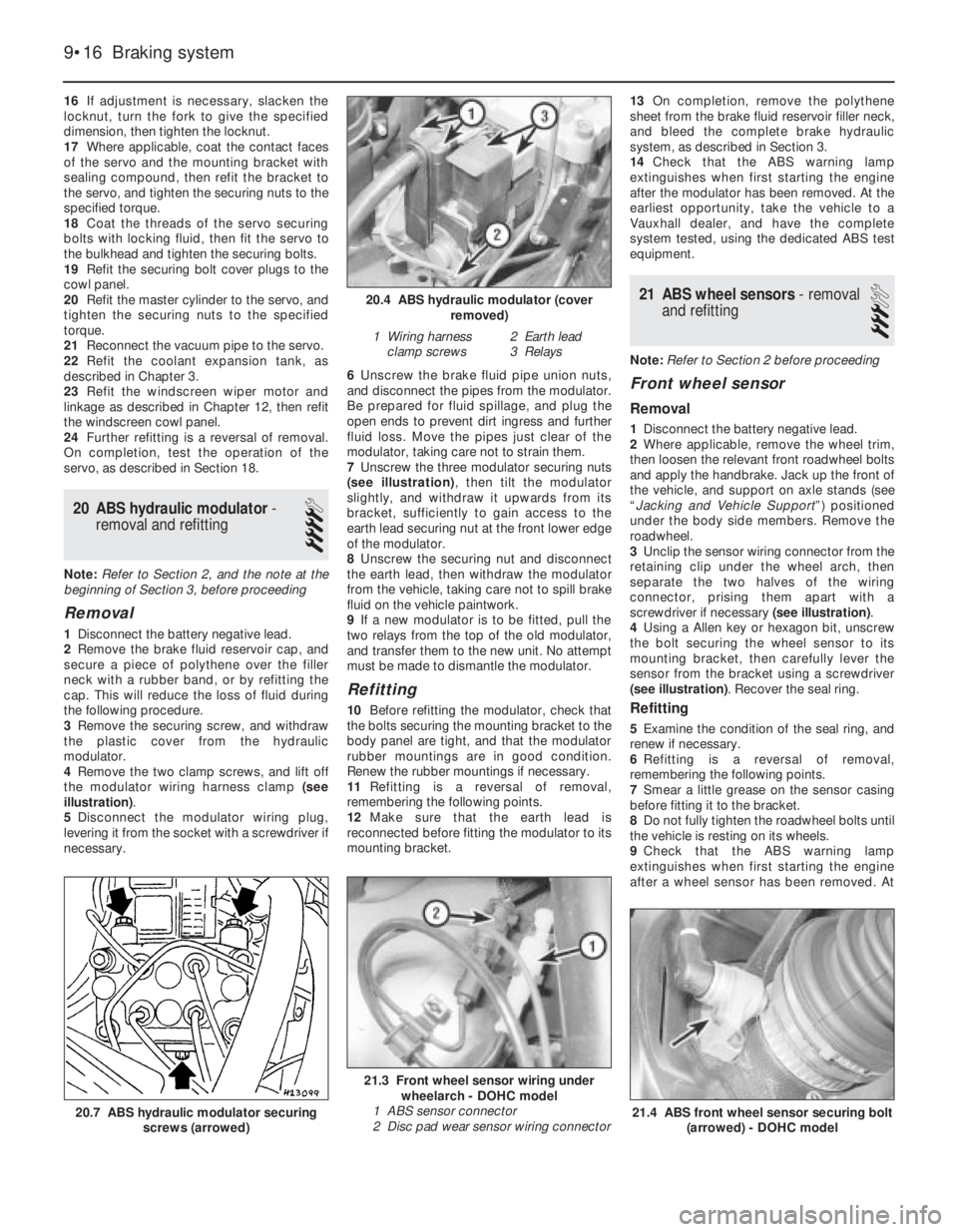
16If adjustment is necessary, slacken the
locknut, turn the fork to give the specified
dimension, then tighten the locknut.
17Where applicable, coat the contact faces
of the servo and the mounting bracket with
sealing compound, then refit the bracket to
the servo, and tighten the securing nuts to the
specified torque.
18Coat the threads of the servo securing
bolts with locking fluid, then fit the servo to
the bulkhead and tighten the securing bolts.
19Refit the securing bolt cover plugs to the
cowl panel.
20Refit the master cylinder to the servo, and
tighten the securing nuts to the specified
torque.
21Reconnect the vacuum pipe to the servo.
22Refit the coolant expansion tank, as
described in Chapter 3.
23Refit the windscreen wiper motor and
linkage as described in Chapter 12, then refit
the windscreen cowl panel.
24Further refitting is a reversal of removal.
On completion, test the operation of the
servo, as described in Section 18.
20ABS hydraulic modulator -
removal and refitting
4
Note: Refer to Section 2, and the note at the
beginning of Section 3, before proceeding
Removal
1Disconnect the battery negative lead.
2Remove the brake fluid reservoir cap, and
secure a piece of polythene over the filler
neck with a rubber band, or by refitting the
cap. This will reduce the loss of fluid during
the following procedure.
3Remove the securing screw, and withdraw
the plastic cover from the hydraulic
modulator.
4Remove the two clamp screws, and lift off
the modulator wiring harness clamp (see
illustration).
5Disconnect the modulator wiring plug,
levering it from the socket with a screwdriver if
necessary.6Unscrew the brake fluid pipe union nuts,
and disconnect the pipes from the modulator.
Be prepared for fluid spillage, and plug the
open ends to prevent dirt ingress and further
fluid loss. Move the pipes just clear of the
modulator, taking care not to strain them.
7Unscrew the three modulator securing nuts
(see illustration), then tilt the modulator
slightly, and withdraw it upwards from its
bracket, sufficiently to gain access to the
earth lead securing nut at the front lower edge
of the modulator.
8Unscrew the securing nut and disconnect
the earth lead, then withdraw the modulator
from the vehicle, taking care not to spill brake
fluid on the vehicle paintwork.
9If a new modulator is to be fitted, pull the
two relays from the top of the old modulator,
and transfer them to the new unit. No attempt
must be made to dismantle the modulator.
Refitting
10Before refitting the modulator, check that
the bolts securing the mounting bracket to the
body panel are tight, and that the modulator
rubber mountings are in good condition.
Renew the rubber mountings if necessary.
11Refitting is a reversal of removal,
remembering the following points.
12Make sure that the earth lead is
reconnected before fitting the modulator to its
mounting bracket.13On completion, remove the polythene
sheet from the brake fluid reservoir filler neck,
and bleed the complete brake hydraulic
system, as described in Section 3.
14Check that the ABS warning lamp
extinguishes when first starting the engine
after the modulator has been removed. At the
earliest opportunity, take the vehicle to a
Vauxhall dealer, and have the complete
system tested, using the dedicated ABS test
equipment.
21ABS wheel sensors - removal
and refitting
3
Note: Refer to Section 2 before proceeding
Front wheel sensor
Removal
1Disconnect the battery negative lead.
2Where applicable, remove the wheel trim,
then loosen the relevant front roadwheel bolts
and apply the handbrake. Jack up the front of
the vehicle, and support on axle stands (see
“Jacking and Vehicle Support”) positioned
under the body side members. Remove the
roadwheel.
3Unclip the sensor wiring connector from the
retaining clip under the wheel arch, then
separate the two halves of the wiring
connector, prising them apart with a
screwdriver if necessary (see illustration).
4Using a Allen key or hexagon bit, unscrew
the bolt securing the wheel sensor to its
mounting bracket, then carefully lever the
sensor from the bracket using a screwdriver
(see illustration). Recover the seal ring.
Refitting
5Examine the condition of the seal ring, and
renew if necessary.
6Refitting is a reversal of removal,
remembering the following points.
7Smear a little grease on the sensor casing
before fitting it to the bracket.
8Do not fully tighten the roadwheel bolts until
the vehicle is resting on its wheels.
9Check that the ABS warning lamp
extinguishes when first starting the engine
after a wheel sensor has been removed. At
9•16Braking system
20.4 ABS hydraulic modulator (cover
removed)
1 Wiring harness
clamp screws2 Earth lead
3 Relays
21.3 Front wheel sensor wiring under
wheelarch - DOHC model
1 ABS sensor connector
2 Disc pad wear sensor wiring connector
21.4 ABS front wheel sensor securing bolt
(arrowed) - DOHC model20.7 ABS hydraulic modulator securing
screws (arrowed)
Page 148 of 525
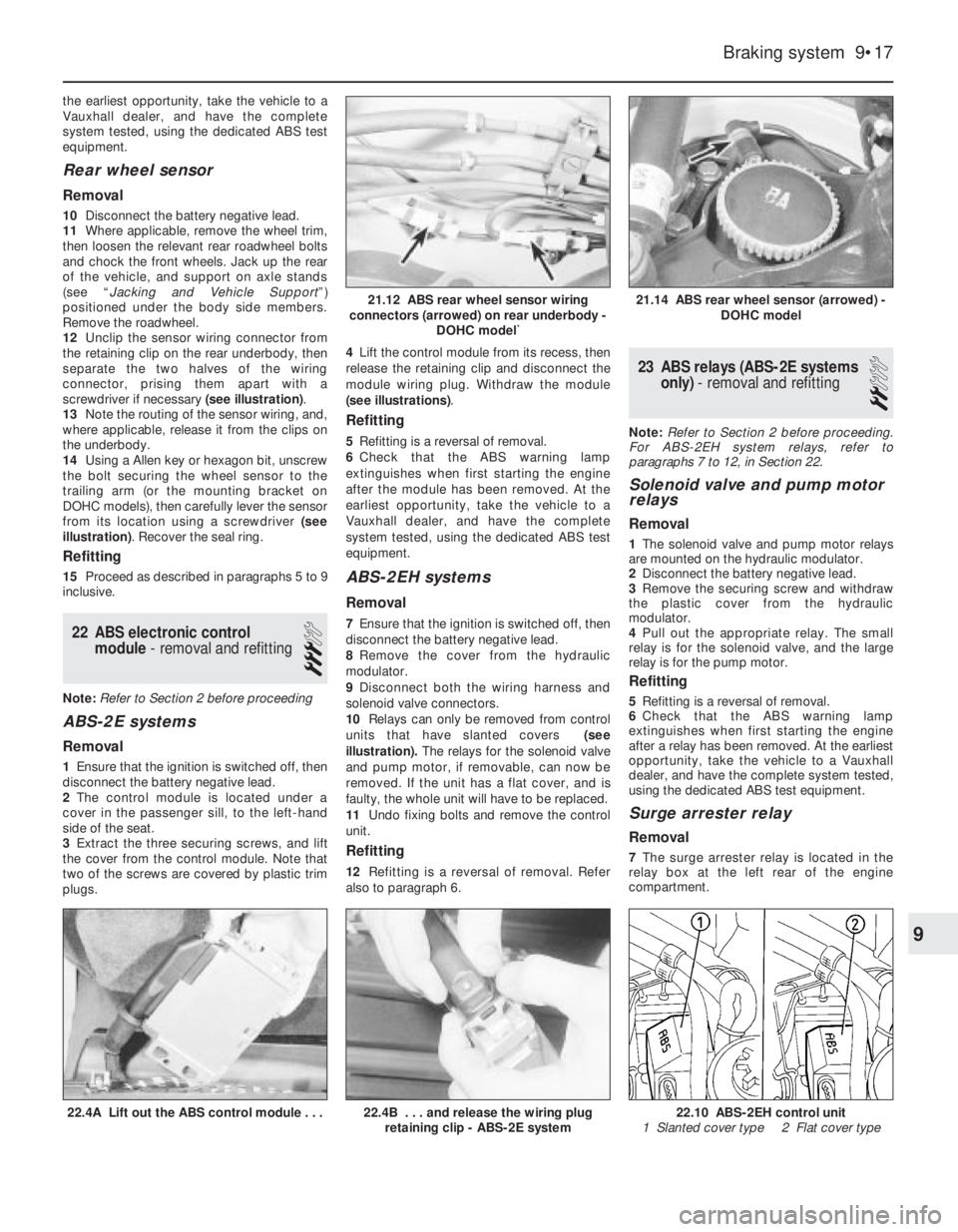
the earliest opportunity, take the vehicle to a
Vauxhall dealer, and have the complete
system tested, using the dedicated ABS test
equipment.
Rear wheel sensor
Removal
10Disconnect the battery negative lead.
11Where applicable, remove the wheel trim,
then loosen the relevant rear roadwheel bolts
and chock the front wheels. Jack up the rear
of the vehicle, and support on axle stands
(see “Jacking and Vehicle Support”)
positioned under the body side members.
Remove the roadwheel.
12Unclip the sensor wiring connector from
the retaining clip on the rear underbody, then
separate the two halves of the wiring
connector, prising them apart with a
screwdriver if necessary (see illustration).
13Note the routing of the sensor wiring, and,
where applicable, release it from the clips on
the underbody.
14Using a Allen key or hexagon bit, unscrew
the bolt securing the wheel sensor to the
trailing arm (or the mounting bracket on
DOHC models), then carefully lever the sensor
from its location using a screwdriver (see
illustration). Recover the seal ring.
Refitting
15Proceed as described in paragraphs 5 to 9
inclusive.
22ABS electronic control
module - removal and refitting
3
Note: Refer to Section 2 before proceeding
ABS-2E systems
Removal
1Ensure that the ignition is switched off, then
disconnect the battery negative lead.
2The control module is located under a
cover in the passenger sill, to the left-hand
side of the seat.
3Extract the three securing screws, and lift
the cover from the control module. Note that
two of the screws are covered by plastic trim
plugs. 4Lift the control module from its recess, then
release the retaining clip and disconnect the
module wiring plug. Withdraw the module
(see illustrations).
Refitting
5Refitting is a reversal of removal.
6Check that the ABS warning lamp
extinguishes when first starting the engine
after the module has been removed. At the
earliest opportunity, take the vehicle to a
Vauxhall dealer, and have the complete
system tested, using the dedicated ABS test
equipment.
ABS-2EH systems
Removal
7Ensure that the ignition is switched off, then
disconnect the battery negative lead.
8Remove the cover from the hydraulic
modulator.
9Disconnect both the wiring harness and
solenoid valve connectors.
10Relays can only be removed from control
units that have slanted covers (see
illustration). The relays for the solenoid valve
and pump motor, if removable, can now be
removed. If the unit has a flat cover, and is
faulty, the whole unit will have to be replaced.
11Undo fixing bolts and remove the control
unit.
Refitting
12Refitting is a reversal of removal. Refer
also to paragraph 6.
23ABS relays (ABS-2E systems
only) - removal and refitting
2
Note: Refer to Section 2 before proceeding.
For ABS-2EH system relays, refer to
paragraphs 7 to 12, in Section 22.
Solenoid valve and pump motor
relays
Removal
1The solenoid valve and pump motor relays
are mounted on the hydraulic modulator.
2Disconnect the battery negative lead.
3Remove the securing screw and withdraw
the plastic cover from the hydraulic
modulator.
4Pull out the appropriate relay. The small
relay is for the solenoid valve, and the large
relay is for the pump motor.
Refitting
5Refitting is a reversal of removal.
6Check that the ABS warning lamp
extinguishes when first starting the engine
after a relay has been removed. At the earliest
opportunity, take the vehicle to a Vauxhall
dealer, and have the complete system tested,
using the dedicated ABS test equipment.
Surge arrester relay
Removal
7The surge arrester relay is located in the
relay box at the left rear of the engine
compartment.
Braking system 9•17
22.4A Lift out the ABS control module . . .22.10 ABS-2EH control unit
1 Slanted cover type 2 Flat cover type22.4B . . . and release the wiring plug
retaining clip - ABS-2E system
21.14 ABS rear wheel sensor (arrowed) -
DOHC model21.12 ABS rear wheel sensor wiring
connectors (arrowed) on rear underbody -
DOHC model`
9